Contagious diffusion definition
What is it?
What are some values that are not for different diseases?
And what factors influence what those values are?
So the definition this is an epidemiological term and are not is the primary reproduction number or ratio. It is not a rate.
So R0 represents the average number of new infections generated by each infected person. So high values mean that it’s easy to transmit and low values mean it isn’t easy to transmit. Now there’s a big assumption here it assumes no pre-existing immunity. So everyone is susceptible.
So that means no one has been exposed to the disease before saying it’s new in humans. And no one has been vaccinated against it. Okay, so those are fundamental assumptions here.
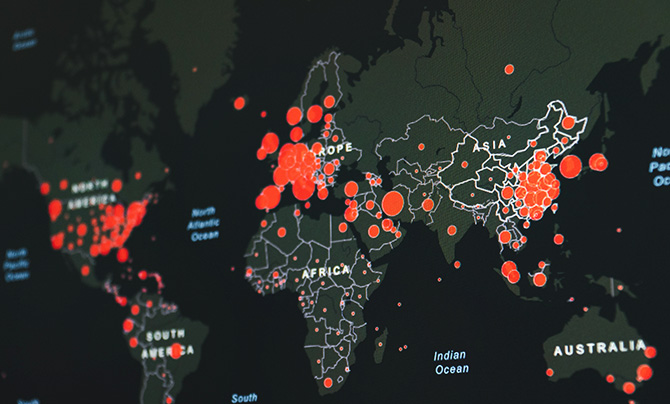
There are three options or the values of R0.
● It can be less than 1. which means the number of new cases will decrease over a fantastic time.
● It can be equal to 1. which means the case number is stable over time.
● Or it can be greater than 1. which means that the outbreak is self-sustaining unless control measures are implemented.
We’re going to look at all three cases in a variety of ways.
Here’s what it looks like when R0=1. What does that mean it means that one person infects another person. Now, these individuals will either recover hopefully or die in a worst-case scenario. But each person infects only one other person. so probably what you see here is that the number of cases remains stable over time.
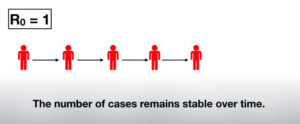
If R0 is less than 1(R0=0.25), so let’s say it’s 0.25 okay now obviously humans aren’t infecting a quarter of another human right. This is an average over a population, but hopefully, you get where I am going with this. Over time the number of cases will decrease and will eventually basically die out. That’s a good thing.
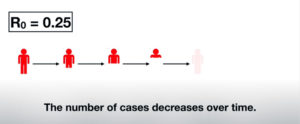
When R0 is higher than one, let’s say R0=2. So when each person infects two people, and those two people infect two people. And so on and so on you can see how the number of cases will increase over time. And it only gets worse the more significant that is not value gets.
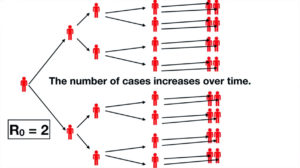
So here’s R0=3. And things started to get a little messy here the same number of cycles now I’ve got a one people infected.
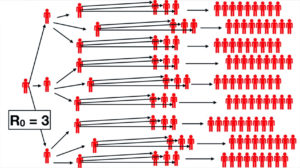
If you look at something like an R0=18, I couldn’t do all the generations here obviously these numbers get huge very fast.
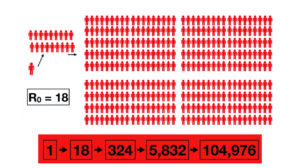
Let’s put this in context and look at some different R0 values for various diseases. And by the way, I got these data for are not from the CDC website; they have high historical data. These average hepatitis C and Ebola. I’m talking about the 2014 Ebola epidemic are not reported around two. SARS and HIV around four. Smallpox and rubella seven. Chickenpox and mumps ten. Measles is as high as 18.
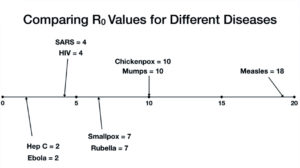
Remember this guy yeah. Measles. Please notice I’m expanding the lower end of this line so we can look at some more diseases down here MERS 0.75. and maybe now you can see how that disease fizzled out over time right the R0 is less than 1.
H1N1 that’s the 2009 influenza pandemic that I’m talking about R0 of about 1.5. the 1918 influenza pandemic 2.2. by the way that was also an H1N1 virus with genes of avian origin.
That pandemic lasted from January of 1918 until December of 1920, and an estimated 500 million people became infected. That’s about a third of the world population. The number of deaths estimated at 50 million, although people think that that number is drastically underreported.
Seasonal influenza ranges between 0.9 and 2.1. and COVID 19 is coming in right now at between 2-3. That number is expected to drop as we get more data, and more people globally are tested.
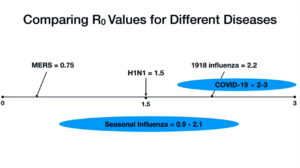
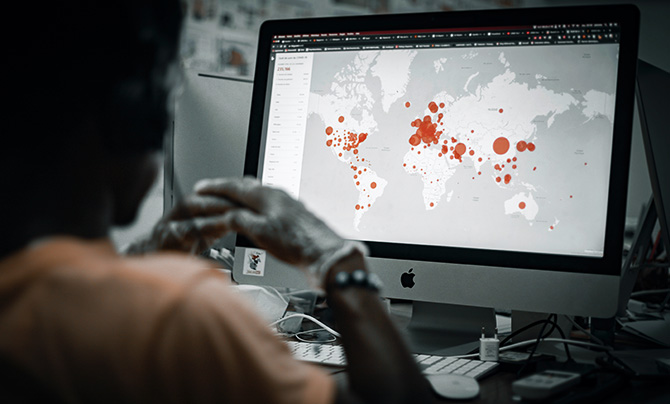
The value of R0 depends on three factors.
01-Duration of infectiousness.
● How long can an infected person give the disease to other people.
● That’s not as simple as it sounds because it varies it seems genetically with individuals, and it depends on the state of infection that the person is experiencing. We know that at different stages of the disease, people shed different amounts of viral particles.
02-Probability of transmission between an infected and a susceptible person.
● Now that depends on the type of contact and the method of transmission of the pathogen.
● So R0 is going to be higher when you’re looking at diseases with a droplet or aerosol transmission.
● And it’s going to be lower when transfer requires an exchange of bodily fluids.
03-The third factor has to do with the average rate of contact between infected and susceptible individuals.
● This is variable, and it depends on what kind of lifestyle what type of living situation work environment and social activities etc. that an individual has.
So here we go the first two factors are affected by the characteristics of the pathogen and the host meaning. That’s determined by biology. This third one is affected by behaviour, and that’s where things like social distancing play their role.
● Finally, some challenges here we don’t know the value of R0 until the outbreak is over and that does frustrate us, but that’s just the reality of how this works.
● R0 is also an average, and there are people that we call super spreaders.
● Is something called the 20/80 rule (so 20% of infected people can be responsible for up to 80% of transmissions)
● Most famous examples of this was “typhoid mary”. She was an Irish cook, and she infected at least 51 people, three of whom died. But she was asymptomatic, and she’s now known as a super spreader.
● Some other challenges things like how we define a case?
● Those who test positive? What about suspected cases?
And different healthcare systems around the world treat these things differently, and that makes the calculation of R0 difficult.
● Time is also significant. There are delays in requesting and receiving tests. Getting your results back and getting the results from an individual back to health authorities.
● So usually what we see is at the beginning of an epidemic or pandemic. Those values of R0 are very high, and they start to fall as testing improves, and we begin testing individuals who are not showing symptoms for the disease.
It’s a lot, I know. I hope that was helpful. Thank you so much for visiting our website. Wishing health safety and peace to everyone. Good luck.

